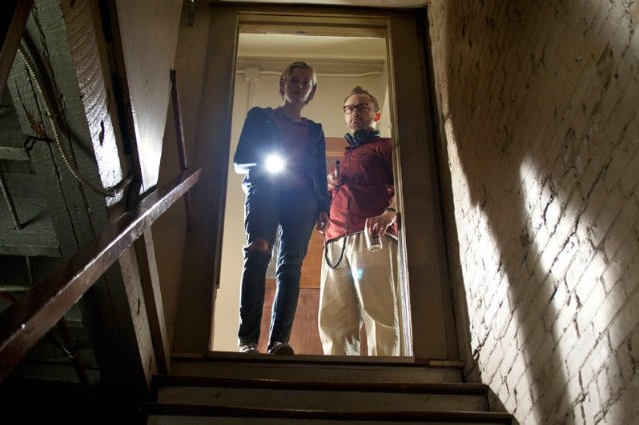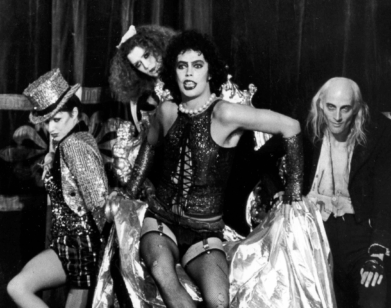Ti West Revisits the Scene

ABOVE: SARA PAXTON (LEFT) AND PAT HEALY IN A STILL FROM THE INNKEEPERS, COURTESY OF MAGNOLIA PICTURES
In a sleepy New England village, two bored teenagers sit behind the desk of the Yankee Pedlar, a small, quiet, soon-to-close inn. When they’re not drinking beer or being annoyed by the employee at the coffee shop next door, they’re amateur ghost hunters. Armed with a video camera, audio equipment, and a website to document their research, Claire (Sara Paxton) and Luke (Pat Healy) half-heartedly seek out the spirits walking among them. But when a former actress and amateur spiritualist rents a room at the inn, the ghosts that haunt the halls become frighteningly real.
Interview sat down with West to talk about the haunted location of the film, working with a tight budget, and making a horror movie for people who don’t like horror movies.
CRAIG HUBERT: Where did you shoot The Innkeepers?
TI WEST: Torrington, Connecticut.
HUBERT: Wasn’t The House of the Devil shot nearby?
WEST: It was in Lime Rock. When we were making The House of the Devil, we stayed at the Yankee Pedlar, because it was a cheap place to stay. We were making this Satanic horror movie in the middle of nowhere, but weirder stuff was going on back at the hotel. Everyone was convinced it was haunted, the whole town thinks it’s haunted, the place is really kooky—when I decided I wanted to make a ghost movie, I was like, whoa: we lived one. What if I just wrote that one? What if we went back, how weird would that be?
HUBERT: How receptive initially were the people who owned the hotel?
WEST: Thankfully, very receptive. The thing is, I wrote the movie very quickly, and I called Pete [Phok], the producer, and was like: “Dude, I wrote this movie about the Pedlar. Think we could go back?” Then I realized: if she says no, this is scrapped. It would be like if you wrote a movie about a real person, not based on them, and they were like, “I don’t want to be in it.” It can’t be someone else’s movie. I kind of backed myself into a corner.
HUBERT: When you went back to The Yankee Pedlar to make The Innkeepers, was anybody hesitant to go back?
WEST: Yes, but it’s not a scary place—it’s a kooky place. I don’t believe in ghosts, but the closest I’ve ever come is staying at The Pedlar. It’s a funny place, because it’s this weird mixture of 1800s, historic architecture, and bad 1970s renovation, everyone who works there is in their 20s. There is something weird about it. We all kind of rolled our eyes, because most of the same crew was coming back. I remember Sara Paxton, when I met her; I tried to get her so psyched for the film. I told her we were going to live and shoot in the hotel, and it’s really haunted, I showed her pictures. What I didn’t realize was that I scared the shit out of her. I got a call from her agent, saying, “Sara doesn’t want to stay at the hotel.” I overhyped it. But I convinced her to come stay one night, she did, and it was fine.
HUBERT: How much did you change the look of the place? Does it look in the movie exactly as it does in real life?
WEST: We changed it a lot, but if you walked in there today, you would think we changed nothing. What we changed is very subtle. I had a very specific color palette for the movie, so just made sure we stayed within that.
HUBERT: What was your budget like this time around?
WEST: Around $800,000.
HUBERT: Is that bigger than The House of the Devil?
WEST: No, smaller. I’m going backwards. [laughs]
HUBERT: I ask only because I wanted to know about the freedoms of working within a smaller budget.
WEST: If somebody would give me more money, I would take it. Nobody wants to spend money on anything, anymore. One of the salient points was: we can make this movie now, everyone is lined up and ready to go and, we can make it a little cheaper than The House of the Devil, which was $900,000.
HUBERT: Obviously, you’re not letting the smaller budget stop you from working.
WEST: You can’t. Look, this is a weird movie, and if we had more money I don’t know what we would have done with it. I guess there would be some crane shots. There would be a couple things I had to cut out of the script that we couldn’t do. It wouldn’t have made a tremendous difference. With The House of the Devil, it would have been great to have more so we could burn the house down, which was supposed to happen. Even if I didn’t burn it down in real life, I could have gotten really good effects; but we couldn’t, so it doesn’t. The next movie I’m doing, I don’t want to do for $800,000, because I can’t pull it off. It’s a science-fiction movie, and I need to build the set, which is a spaceship. There’s no way for that not to cost a certain amount of money. Low-budget movies is fine for me, I have no qualms about it, but when you want to do something—build a spaceship, or do a crane shot—and you look at everybody, and go, “We’ll just put the camera over here instead,” that’s a shame, because enough of that happens and you get a little worn down.
HUBERT: Maybe it’s a restraint of the budget, but there is something really interesting about using, essentially, one enclosed space for your film. Were you looking at guys like Roman Polanski, who have done similar things? This kind of film works great in small, confined, spaces.
WEST: I agree. I don’t know if I’m directly inspired, but I’m quite fond of Polanski’s trilogy of Repulsion, The Tenant, and Rosemary’s Baby. But I would like to make my Chinatown, for sure.
HUBERT: You said you worked with the same crew this time around, but the actors are all new. Did you find them through the normal channels?
WEST: I kind of knew Pat Healy. He used to live with a friend of mine. Sara Paxton, I wasn’t familiar with. Her agent submitted her. She was doing a film with a friend of mine, and I called my friend, who went on and on about how great she was. So I called Sara on the phone, and she really got the material. Surprisingly, a lot of people didn’t.
HUBERT: What was the problem?
WEST: They didn’t get the minimum-wage, hangout vibe. Sara understood the movie from the get-go. Then she came to LA and we met, and I discovered she’s a ridiculous goofball. I had to exploit this. She’s much closer to this character than anyone else she’s ever played. It was all on the page, but she takes it to another level. It was important to me to get people who are really talented, and collaborative, but also cool human beings. Making movies is traumatic. If there was one asshole that alienates everybody, than the whole thing sucks. I have a really good crew who are talented, but as people, I love them.
HUBERT: Kelly McGillis was a huge surprise for me.
WEST: The producers of the movie had made another movie with her, called Stake Land, and they recommend her. I thought everyone was going to want to do that role, but I didn’t realize that older actresses have no sense of humor about being older actresses. They were all offended I would ever offer them the role. Kelly had a good self-deprecating sense of humor, and no ego about herself.
HUBERT: I wanted to ask you about the structure of the film, which is separated into chapters.
WEST: I felt it’s a very, old-fashioned, traditional ghost story. I wanted to present the movie in a very classical format but have the people in it out of place. It has this posturing, but the people in it are these lazy kids. That kind of irony is interesting to me. With the chapters, it’s also nice to set something up, it helps with the suspense.
HUBERT: I’ve noticed you have not mentioned horror yet, and I didn’t necessarily think of this film as horror. But that is an easy tag people will attach to the film, but better or worse.
WEST: I think it’s a horror movie. It’s just that horror, these days, is just lowest common denominator. This film is in the minority of today’s horror movies. A lot of people go, “I don’t watch horror movies.” Well, you might like mine. I always try to rope people in who don’t watch horror movies. I figure, you might not watch horror movies, but you’ll be all right with mine.
THE INNKEEPERS IS OUT NOW ON VIDEO ON DEMAND AND WILL BE RELEASED THEATRICALLY ON FEBRUARY 3.






